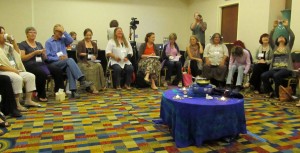What is Transformational Leadership?
2012
Two Perspectives on Transformational Leadership
Dr. Amit Nagpal, New Delhi, India, and
Dr. Janet Smith Warfield, Florida, USA
_______________________________________________________________________________________
Dr. Amit Nagpal’s Perspective
 Become a leader who transforms by being a thought leader.
Become a leader who transforms by being a thought leader.
I am not going to talk about what is transformational leadership. I am not going to impose my views. I will not even tell you how to become a transformational leader. Now you must be thinking, “Then what the hell are you going to do?”
I had once posted on Facebook, “Your secret is in your soul, my secret is in my soul and still they tell you to read ‘The Secret’” Even Lord Buddha said, “Everyone must find his own way to salvation.” Why should we have any one definition of transformational leadership? Why not ask your soul and come up with your own definition? We all can be transformational leaders in our own ways, whether we transform our village, our workplace, our family or even one friend. When we connect to our deepest self, and become authentic in expressing our true self, we will automatically become a leader who transforms and a thought leader who leads by example.
Albert Einstein said, “Everybody is a genius. But if you judge a fish by its ability to climb a tree, it will live its whole life believing that it is stupid.” Are you a fish who is trying to climb the tree? Is your organization making you a square peg (unfit) in a round hole?
Start the journey of finding your genius. When you find your genius, you will become a leader who transforms by being a thought leader. I will just tell you one possible approach or a road map to thought leadership. You have to undertake your own journey, I can only support you, inspire you and give a suggested road map which you can modify or even use to get an idea to develop your own road map.
Here is my three step approach to thought leadership:-
Step 1
Walk the Walk
Connect with your deepest self through contemplative practice, expressing yourself through arts or appreciating art in a way that it becomes your muse or source of inspiration.
Develop your own concept of thought leadership. Stay in the company of thought leaders and find inspiration. Respect your genius and it will make you a thought leader. I remember another quote of Einstein, “The intuitive mind is a sacred gift and the rational mind is a faithful servant.” Honour your gift to bring out your hidden greatness. Let the silent-intuitive mind take over and make you a thought leader in your own right. Take the action to develop models, philosophy, equations, and diagrams and so on which can depict your ideas.
Step 2
Talk the Talk
Communicate your authentic core to the people around. Share your thought leadership with people who are going to either support you or criticize you constructively (to help you refine your concept further).
Help the people understand your thought leadership model. Unless you help them gain in-depth understanding of your ideas, they will have a superficial understanding only. Even God had to communicate his message through epics, religious books and inspired messages to her channels. Never claim to be a thought leader and let the people validate your thought leadership.
Step 3
Walk the Talk
You are in the implementation phase now. Fine tune whenever you feel like it. Apply the thought leadership to your own life or to the lives of people/organisations you know. Demonstrate results. Counter the opposition with conviction and determination.
“Easier said than done” they say. Contemplation is fine to connect with the deepest self but at the end of the day life is action, not contemplation. Start the spark and fuel the fire. I once jokingly told a client, “Coins make noise and notes don’t. As you grow from 1 rupee coin to 10 rupee coin to a 1,000 rupees note, make less and less noise.” So become humbler by the day. I always tell my clients, “Larger the stature, Briefer the profile”
You have walked enough, you have talked enough, and the time has come to ‘Walk the Talk’. Leave your own footprint of transformation through your ‘Thought Leadership’.
One day, leadership has to die because everyone will become capable enough to lead himself/herself (by mastering the mind and by connecting to the soul.). One day everyone will be a thought leader. You want to be an innovator or a laggard. The life is yours, the choice is yours.
http://suewaters.wikispaces.com/
_______________________________________________________________________________________
Dr. Amit Nagpal is a Personal Branding Consultant, passionate Blogger, and Motivational Speaker based in New Delhi, India. He specializes in personal branding with a holistic touch. His philosophy is “Take Charge of your Life and your Brand” He writes a Blog, “The Joys of Teaching”
_______________________________________________________________________________________
Dr. Janet Smith Warfield’s Perspective
“The next Buddha might not be an individual. It might be a group” Thich Nhat Hanh
 A MetaHub of a dozen brilliant, talented, aware women have self-organized out of Barbara Marx Hubbard’s Agents of Conscious Evolution Mentors, http://bit.ly/KzuGiC, to dialog about any subject any of them wants to discuss. The topics are not about hair styles or the latest fashions. They are about how to heal ourselves, how to heal our planet, and how to co-create harmony, resonance, and alignment with one another. Each speaks into the circle from her heart. Each listens deeply to the others’ words. New ears and perspectives hear the information offered into the circle. New speakers add their own nuances, perspectives, and understandings. Ultimately, the dialog carries everyone to a clearer and more expanded understanding of the topic being discussed. Disparate viewpoints coalesce into alignment and resonance. Conflicts dissipate as new information enters the circle. Everyone comes together to solve problems.
A MetaHub of a dozen brilliant, talented, aware women have self-organized out of Barbara Marx Hubbard’s Agents of Conscious Evolution Mentors, http://bit.ly/KzuGiC, to dialog about any subject any of them wants to discuss. The topics are not about hair styles or the latest fashions. They are about how to heal ourselves, how to heal our planet, and how to co-create harmony, resonance, and alignment with one another. Each speaks into the circle from her heart. Each listens deeply to the others’ words. New ears and perspectives hear the information offered into the circle. New speakers add their own nuances, perspectives, and understandings. Ultimately, the dialog carries everyone to a clearer and more expanded understanding of the topic being discussed. Disparate viewpoints coalesce into alignment and resonance. Conflicts dissipate as new information enters the circle. Everyone comes together to solve problems.
Is this a new style of leadership? If so, what do we call it? Field leadership? Essence Leadership? Circle Leadership? Transformational leadership? Are we co-creating the Noosphere which Teihard de Chardin wrote about so many years ago, simply by exchanging information through deep, heartfelt, mutually-respective dialog?
Talking circles are not new. Indigenous people in North America have used them for millennia. Circles of stones or wood can be found all over Europe, some dating back 5,000 years or more. Circles bring people together, co-creating positive transformation for all. As Living Justice Press states:
Circles are far more than a technique; they are a way of life. Circles embody a philosophy, principles, and values that apply whether people are sitting in Circle or not. http://bit.ly/L3SE8r
Characteristics of Transformational Leadership:
- All inclusive – everyone belongs and has the right to speak
- Everyone is equal
- Those who are not speaking are listening deeply
- Can be used in any setting with any topic
- Draws on our best values
- Solutions evolve organically
- Endlessly adaptable and co-creative
- Helps participants respond from their best selves because they are being heard rather than suppressed.
- Builds community
- Generates mutual understanding and respect
- Honors all voices equally
- Decisions are made by consensus
- Cultivates mutual support
- Honors the gifts, knowledge, talent and experiences each participant brings.
There are many modern circle groups engaged in this kind of transformational community building and leadership. Two I can recommend are Vistar Circles, http://www.vistarfoundation.org/ and Circle Connections, http://circleconnections.com/. They continue to be used because they bring to every participant such a wonderful sense of inclusiveness and community building. When a circle is formally over, the participants rarely want to leave the safe, free-flowing space they have created together.
Perhaps Thich Nhat Hanh was right. The next Buddha is all of us co-creating together in peace and harmony.
Additional Resources
- First Nations Pedagogy Online (Circle Talks) – http://bit.ly/KxrgSa
- Living Justice Press – http://bit.ly/MueLo4
_______________________________________________________________________________________
Dr. Janet Smith Warfield serves wisdom-seekers who want understanding and clarity so they can live peaceful, powerful, prosperous lives. Through her unique combination of holistic, creative, right-brain transformational experiences and 22 years of rigorous, left-brain law practice, she has learned how to sculpt words in atypical ways to shift her listeners into experiences beyond words, transforming turmoil into inner peace. For more information, see www.wordsculptures.com, www.wordsculpturespublishing.com, www.janetsmithwarfield.com
_______________________________________________________________________________________


 “The bell of mindfulness is the voice of the Buddha calling us back to ourselves. We have to respect each sound of the bell, stop our THINKING AND TALKING and get in touch with ourselves, breathing and smiling. This is not the Buddha from the outside. It is our own Buddha calling us home.”
“The bell of mindfulness is the voice of the Buddha calling us back to ourselves. We have to respect each sound of the bell, stop our THINKING AND TALKING and get in touch with ourselves, breathing and smiling. This is not the Buddha from the outside. It is our own Buddha calling us home.”










Comment